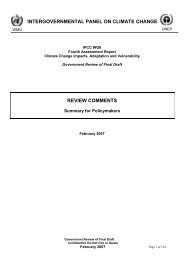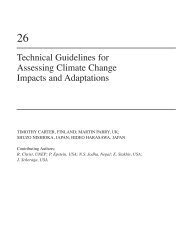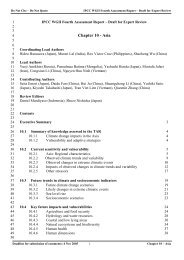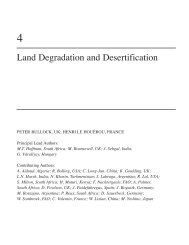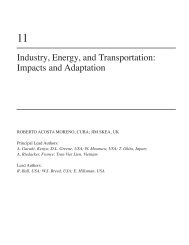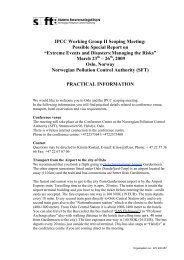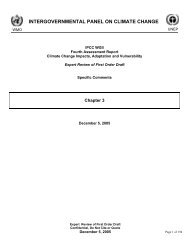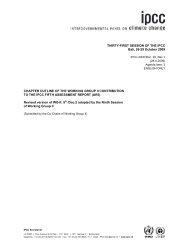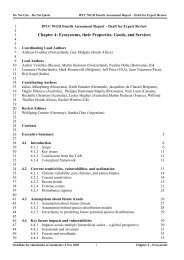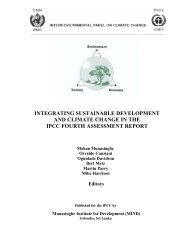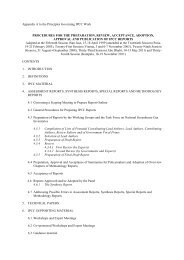IPCC Expert Meeting on Geoengineering
IPCC Expert Meeting on Geoengineering
IPCC Expert Meeting on Geoengineering
You also want an ePaper? Increase the reach of your titles
YUMPU automatically turns print PDFs into web optimized ePapers that Google loves.
Annex 3: Keynote Abstracts<br />
Keynote III-3: <strong>Geoengineering</strong> in a Risk Management Framework<br />
M. Granger Morgan<br />
Department of Engineering and Public Policy, Carnegie Mell<strong>on</strong> University, USA<br />
C<strong>on</strong>venti<strong>on</strong>al tools of risk analysis and decisi<strong>on</strong> support (including the use of failure mode and effects analysis and fault<br />
trees, combined with modern methods for assessing risk percepti<strong>on</strong>s and engaging in risk communicati<strong>on</strong>) are entirely<br />
appropriate for use in risk management of that subset of CDR that uses engineered systems designed to scrub CO 2 from the<br />
atmosphere. After a few general preliminaries about the state of modern risk analysis and management, the talk will briefly<br />
outline strategies that can be used for risk management of engineered systems for CDR. These systems lie in regi<strong>on</strong> A of<br />
Figure A.3.2.<br />
In c<strong>on</strong>trast, c<strong>on</strong>venti<strong>on</strong>al tools for risk analysis and management, and more critically tools for decisi<strong>on</strong> support, are <strong>on</strong>ly<br />
partly adequate to assess CDR that involves large-scale l<strong>on</strong>g-term modificati<strong>on</strong> of ecosystems. Many c<strong>on</strong>venti<strong>on</strong>al tools for<br />
risk management are not adequate to make decisi<strong>on</strong>s related to SRM. Aspects of these strategies lie in regi<strong>on</strong> B of Figure<br />
A.3.2. After articulating some of the reas<strong>on</strong>s for this asserti<strong>on</strong>, a number of important gaps in available analytical methods<br />
will be outlined. A few alternative strategies for framing and thinking about the problem of risk management of SRM<br />
research, and possible future SRM deployment, will be suggested and discussed.<br />
Figure A.3.2: C<strong>on</strong>venti<strong>on</strong>al tools for risk analysis and risk management have been developed to address problems that fall<br />
within the space labeled A. In c<strong>on</strong>trast, aspects of CDR that involves large-scale l<strong>on</strong>g-term modificati<strong>on</strong> of ecosystems, and<br />
aspect of all SRM strategies, lie in the space labeled B. Before applying c<strong>on</strong>venti<strong>on</strong>al tools and methods for risk analysis<br />
and management in this space, <strong>on</strong>e must examine carefully the underlying assumpti<strong>on</strong>s <strong>on</strong> which they have been based.<br />
Figure modified from Morgan et al. (1999).<br />
References<br />
Morgan M.G., M. Kandlikar, J. Risbey, and H. Dowlatabadi, 1999: Why C<strong>on</strong>venti<strong>on</strong>al Tools for Policy Analysis Are Often<br />
Inadequate for Problems of Global Change. Climatic Change 41, 271–281. (DOI: 10.1023/A:1005469411776).<br />
<str<strong>on</strong>g>IPCC</str<strong>on</strong>g> <str<strong>on</strong>g>Expert</str<strong>on</strong>g> <str<strong>on</strong>g>Meeting</str<strong>on</strong>g> <strong>on</strong> <strong>Geoengineering</strong> - 39



